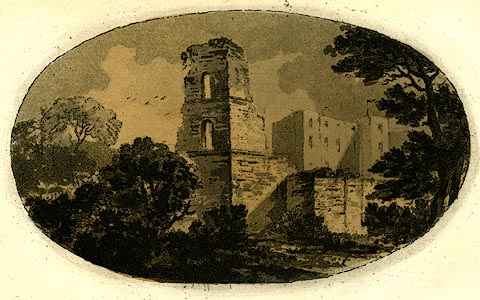

Dove Cottage : 2008.107.427
image:-
© see bottom of page

click to enlarge
Included in vol.2 opposite p.121 in Observations, Relative Chiefly to Picturesque Beauty, made in the year 1772.
The list of plates in the preface of the book has:-
'XX. A view of Scaleby-castle, in which the old tower part of the walls, and the bastion, are represented. Page 121.'
'... About three miles further we visited the ruins of Scaleby-castle. This was another of those fortified houses, which are so frequent in this country.
'It stands, as castles rarely do, on a flat; and yet, tho it's site be ill adapted to any modes of defence, it has been a place of more than ordinary strength. Rocks, knolls, and bold projecting promontories, on which castles usually stand, suggest various advantages of situation; and generally determine the kind of structure. On a flat, the engineer was at liberty to choose his own. Every part was alike open to assault.
'He first drew two circular motes round the spot he designed to fortify: the circumference of the outward circle was somewhat more than half a mile. The earth, thrown out of these two motes, which were broad and deep, seems to have been heaped up at the centre, where there is a considerable rise. On this was built the castle, which was entered by two draw-bridges; and defended by a high tower, and a very lofty wall.
'At present, one of the motes only remains. The other is filled up; but may still be traced. The castle is more perfect, than such buildings usually are. The walls are very intire; and a great part of the tower, which is square, is still left. It preserved it's perfect form, till the civil wars of the last century; when the castle, in too much confidence of it's strength, shut it's gates against Cromwell, then marching into Scotland; who made it a monument of his vengeance.
'What share of picturesque genius Cromwell might have, I know not. Certain however it is, that no man, since Henry the eighth, has contributed more to adorn this country with picturesque ruins. The difference between the two masters lay chiefly with the style of ruins, in which they composed. Henry adorned his landscapes with the ruins of abbeys; Cromwell, with those of castles.
'I have seen many pieces by this master, executed in a very grand style; but seldom a finer monument of his masterly hand than this. He has rent the tower, and demolished two of it's sides; the edges of the other two he has shattered into broken lines. The chasm discovers the whole plan of the internal structure - the vestiges of several stories - the insertion of the arches, which supported them - the windows for speculation; and the breastwork for assault.
'The walls of this castle are uncommonly magnificent. They are not only of great height, but of great thickness; and defended by a large bastion; which appears to be of more modern workmanship. The greatest part of them is chambered within, and wrought into secret recesses. A massy portcullis gate leads to the ruins of what was once the habitable part of the castle, in which a large vaulted hall is the most remarkable apartment; and under it, are dark, and capacious dungeons.
'The area within the mote, which consists of several acres, was originally intended to support the cattle, which should be driven thither in times of alarm. When the house was inhabited (whose chearful and better days are still remembered, (sic) this area was the garden; and all around, on the outside of the mote stood noble trees, irregularly planted, the growth of a century. Beneath the trees ran a walk round the castle; to which the situation naturally gave that pleasing curve, which in modern days hath been so much the object of art. This walk might admit of great embellishment. On one hand, it commands the ruins of the castle in every point of view; on the other, a country, which tho flat, is not unpleasing; consisting of extensive meadows, (which a little planting might turn into beautiful lawns,) bounded by lofty mountains.
'This venerable pile has now undergone a second ruin. The old oaks and elms, the ancient natives of the scene, are felled. Weeds, and spiry grass have taken possession of the courts, and obliterated the very plan of a garden: while the house itself, (whose hospitable roof deserved a better fate,) is now a scene of desolation. Two wretched families, the only inhabitants of the place, occupied the two ends of the vaulted hall, when we saw it, the fragment of a tattered curtain, reaching half way to the top, being the simple boundary of their respective limits. All the rest was waste: no other part of the house was habitable. The chambers unwindowed, and almost unroofed, fluttered with rags of ancient tapestry, were the haunts of daws, and pigeons; which burst out in clouds of dust, when the doors were opened: while the floors, yielding to the tread, made curiosity dangerous. A few pictures, heir-looms of the wall, which have long deserved oblivion, by I know not what fate, were the only appendages of this dissolving pile, which had triumphed over the injuries of time.
'Shakespear's castle of Macbeth could not have been more the haunt of swallows and martins, than this. we saw them every where about the ruins; either twittering on broken coins; threading some fractured arch; or pursuing each other, in screaming circles, round the walls of the castle. [star]'
[footnote/star]:-
'In this old castle the author of this tour was born, and spent his early youth; which must be his apology for dwelling so long upon it.- Since this description was written, it has, in some degree, been repaired.'
 Scaleby Castle
Scaleby Castle